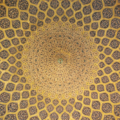 With his long hair whipping, he leaps and bends and twists amid a circle of flames, yet the dance movements are graceful and controlled, the facial expression tranquil. According to Khan Academy, Auguste Rodin once wrote that the sculpture known as Nataraja was the “perfect expression of rhythmic movement in the world,” while the English philosopher Aldous Huxley remarked that the western world has nothing “that approaches the symbolism of this work of art, which is both cosmic and psychological.”
With his long hair whipping, he leaps and bends and twists amid a circle of flames, yet the dance movements are graceful and controlled, the facial expression tranquil. According to Khan Academy, Auguste Rodin once wrote that the sculpture known as Nataraja was the “perfect expression of rhythmic movement in the world,” while the English philosopher Aldous Huxley remarked that the western world has nothing “that approaches the symbolism of this work of art, which is both cosmic and psychological.”
For the uninitiated among anyone reading this, Nataraja represents the Hindu God Shiva in his role as Lord of the Cosmic Dance, in which he dances each great eon into and out of existence. With one of his four arms, he holds a drum from whose staccato rhythm the universe first oozed into existence, while with the other, he holds aloft the flames of destruction that annihilated it, and whose destruction made way for the subsequent eons to follow– each propelled into existence and out again by the drum’s syncopated beat.
In Hindu philosophy, the microcosm mirrors the macrocosm, and hence, through this image we understand that not only do the great eons exist within cyclical restraints, but so does humankind. According to the theory of reincarnation, we are destined to live, die, and then do it all over again ad infinitum—or at least, until we become purified of selfishness (of even any identity with our self), and merge with the Cosmic Soul. For this reason, Shiva raises his third arm in a calming or pacifying gesture, while with the other he points to his upraised foot—indicating release from the cycle of birth and death.
Numerous other symbols abound in the sculpture, but we’ll look at only those that pertain to our current narrative. How do we attain the purity necessary to merge with the Cosmic Soul, thereby attaining release from reincarnation? Enter the dwarf upon which Shiva dances. Called Apasmara, he embodies ignorance of the divine that exists within us, and which, in fact, constitutes the fabric of the universe.
Blinded by our body’s cravings, by desire and aversion, we focus on those things that we believe can satisfy these cravings, and by so doing, bind ourselves to the physical and blind ourselves to the spiritual. We end up serving our own ego, rather than the universal and divine energy that constitutes everything within the Cosmos—including our puny selves.
In the blog argenash3, the author discusses this problem from the perspective of non-duality. He points out that whatever may appear as separate is but an illusion that arises due to our own ignorance. “The energy … that manifests out of (Nataraja) as a ring of fire is not separate from Him because it cannot hold itself or survive without Him. So is the (dwarf) under His feet. If you look carefully… It is connected with Him as well as with the rest of the creation.
…The whole of the image is an assurance to us that creation is not a chaotic and accidental phenomena but a guided and rhythmic movement under the mastery and control of the eternal self (the Cosmic Soul) and that we too can become masters of our own movements and action by liberating ourselves from the limitations of smallness [ego] and delusion [apasmara] that are represented by the dwarf.”
Interestingly, although this dance was originally believed to occur in the temple city of Chidambaram, believed to be the center of the universe by many, it was also understood as occuring within the center of the human heart. In other words, this dance of Nataraja, which portrays the beginning and end of vast cycles of time, as well as the beginning and end of numerous lifetimes, also suggests that we are each incrementally dancing our way into the Absolute, where duality dissolves and all tensions come to rest.
O you the creator, you the destroyer, you who sustain and make an end,
Who in sunlight dance among the birds and the children at play,
Who at midnight dance among the corpses in the burning grounds,
You, Shiva, you dark and terrible Bhairava,
You Suchness and Illusion, the Void and All Things,
You are the lord of life, and therefore I have brought you flowers;
You are the lord of death, and therefore I have brought you my heart—
This heart that is now your burning ground.
Ignorance there and self shall be consumed with fire.
That you may dance, Bhairava, among the ashes.
That you may dance, Lord Shiva, in a place of flowers,
And I dance with you.
Aldous Huxley, Island

